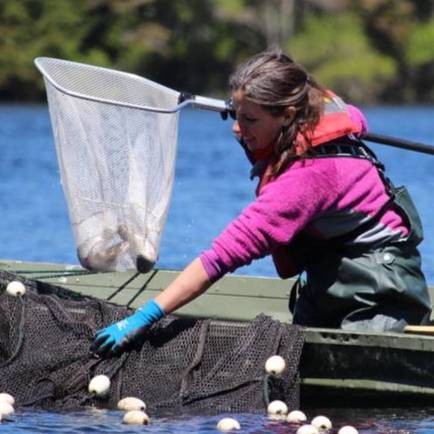Phoebe Zarnetske Has Climate Intervention Paper Published in PNAS
Michigan State University community ecologist Phoebe Zarnetske is co-lead of the Climate Intervention Biology Working Group, a team of internationally recognized experts in climate science and ecology that is bringing science to bear on the question and consequences of geoengineering a cooler Earth.
The group's seminal paper, "Potential ecological impacts of climate intervention by reflecting sunlight to cool Earth," was published in the most recent issue of Proceedings of the National Academy of Sciences of the United States (PNAS).
"There is a dearth of knowledge about the effects of climate intervention on ecology," said Phoebe, associate professor in the Department of Integrative Biology and the paper's lead author. "As scientists, we need to understand and predict the positive and negative effects it could have on the natural world, identify key knowledge gaps, and begin to predict what impacts it may have on terrestrial, marine, and freshwater species and ecosystems if it were adopted in the future."
The costs and technology needed to reflect the sun's heat back into space are currently more attainable than other climate intervention ideas like absorbing carbon dioxide (CO2) from the air. The working group anticipates their lively discussions and open access paper will encourage an explosion of scientific investigation into how a climate intervention strategy known as solar radiation modification (SRM), in tandem with greenhouse gas emissions reduction, would affect the natural world.
The feasibility of planetary-wide SRM efforts hinge on accurate predictions of its myriad outcomes provided by the well-established computer simulations of the Geoengineering Model Intercomparison Project (GeoMIP). The PNAS paper lays the foundation for expanding GeoMIP's scope to include the incredible range and diversity of Earth's ecosystems.
"Most of the GeoMIP models only simulate abiotic variables, but what about all of the living things that are affected by climate and rely on energy from the Sun?" added Phoebe, who is also an Ecology, Evolution, and Behavior program faculty member. "We need to better understand the possible impacts of SRM on everything from soil microorganisms to monarch butterfly migrations to marine systems."
Phoebe's Spatial and Community Ecology Lab (SpaCE Lab) specializes in predicting how ecological communities respond to climate change across scales from the microcosm to the global, making it uniquely poised to assist the working group in illuminating vital data for future SRM scenarios such as stratospheric aerosol intervention (SAI), the focus of the paper.
SAI would reduce some of the Sun's incoming radiation by reflecting sunlight back into space, such as what happens after large volcanic eruptions. Theoretically, it would be possible to continuously replenish the cloud and control its thickness and location to achieve a desired target temperature.
But the paper reveals the under-researched complexity of cascading relationships between ecosystem function and climate under different SAI scenarios. In fact, the scientists argue that climate change mitigation must continue regardless of whether SRM is adopted, and the question remains whether some or any SRM can be beneficial in addition to decarbonization efforts.
"Although SAI may cool Earth's surface to a global temperature target, the cooling may be unevenly distributed, affecting many ecosystem functions and biodiversity," Phoebe said. "Rainfall and surface ultraviolet radiation would change, and SAI would increase acid rain and would not mitigate ocean acidification."
In other words, SRM is not a magic bullet for solving climate change. Until the working group's efforts inspire new research into the effects of different climate intervention scenarios, SRM is more akin to a shot in the dark.
The Climate Intervention Biology Working Group, which is funded by the National Science Foundation, hosted the virtual session, "Biosphere Responses to Geoengineering," at the American Association for the Advancement of Science (AAAS) Annual Meeting in February, and will host a virtual session at the Ecological Society of America Annual Meeting in August.



